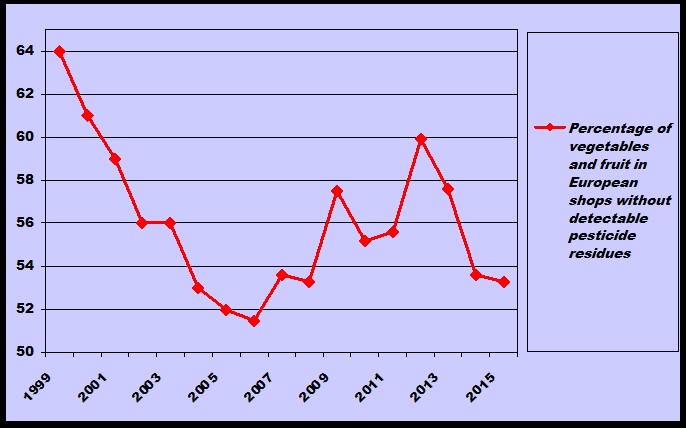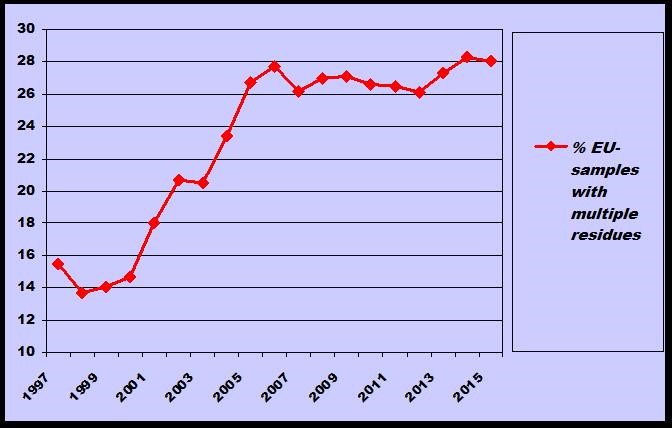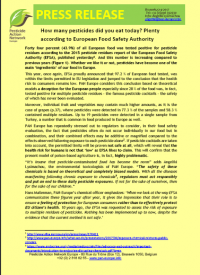Forty-four percent (43.9%) of all European food was tested positive for pesticide residues according to the 2015 pesticide residues report of the European Food Safety Authority (EFSA), published yesterday[1]. And this number is increasing compared to previous years (Figure 1). Whether we like it or not, pesticides have become one of the main ‘ingredients’ of our food in Europe.
This year, once again, EFSA proudly announced that 97.2 % of European food tested, was within the limits permitted in EU legislation and jumped to the conclusion that the health risk to consumers remains low. PAN Europe considers this conclusion based on theoretical models a deception for the European people especially since 28 % of the food was, in fact, tested positive for multiple pesticide residues – the famous pesticide cocktails - the safety of which has never been evaluated.
Moreover, individual fruit and vegetables may contain much higher amounts, as it is the case of grapes (p.37), where pesticides were detected in 77.3 % of the samples and 58.3 % contained multiple residues. Up to 19 pesticides were detected in a single sample from Turkey, a number that is common in food produced in Europe as well.
PAN Europe has repeatedly stressed out to regulators to consider, in their food safety evaluation, the fact that pesticides often do not occur individually in our food but in combination, and their combined effects may be additive or magnified compared to the effects observed following exposure to each pesticide alone[2]. If pesticide cocktails are taken into account, the permitted limits will be proven not safe at all, which will reveal that the health risk for humans is not that ‘low’ as EFSA likes to claim. This will confirm that the present model of poison-based agriculture is, in fact, highly problematic.
“It’s insane that pesticide-contaminated food has become the norm” adds Angeliki Lysimachou, the environmental toxicologists of PAN Europe. “The safety of these chemicals is based on theoretical and completely biased models. With all the diseases manifesting following chronic exposure to chemicals[3], regulators must act responsibly and put an end to these daily pesticide exposures. If not for the sake of ourselves, then for the sake of our children.”
Hans Muilerman, PAN-Europe’s chemical officer emphasizes: ‘When we look at the way EFSA communicates these figures year after year, it gives the impression that their role is to ensure a feeling of protection for European consumers rather than to effectively protect EU citizen’s health. 10 years ago, the EFSA was requested to assess the risk of exposure to multiple residues of pesticides. Nothing has been implemented up to now, despite the evidence that the current method is not safe.’
Figures
In 2015 the percentage of vegetables and fruit in European shops without detectable pesticide residues went down again considerable to 53,3% as was the case in 2013, close to the all-time low in 2007.

In 2015 the percentage of multiple residues in European vegetables and fruit increased again to the extreme high rate of 28 %. Unfortunately, EFSA stopped publishing the data on the highest reported number of pesticides in one sample, which was often up to 30 in one food sample (grapes, raisins).

Contact: Angeliki Lysimachou, angeliki [at] pan-europe.info, +32 2 318 62 55
[1] http://www.efsa.europa.eu/en/press/news/170411
[2] http://www.pan-europe.info/what-we-do/presentations/2017/04/exposure-che...
[3] https://www.endocrine.org/-/media/endosociety/files/advocacy-and-outreac...
